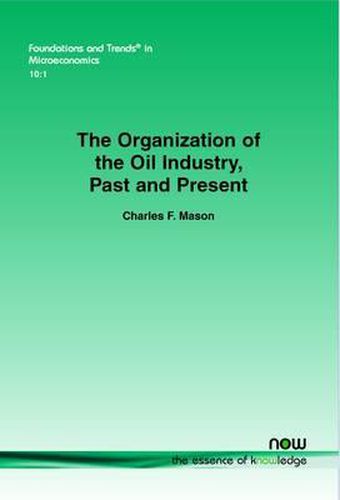Readings Newsletter
Become a Readings Member to make your shopping experience even easier.
Sign in or sign up for free!
You’re not far away from qualifying for FREE standard shipping within Australia
You’ve qualified for FREE standard shipping within Australia
The cart is loading…






This title is printed to order. This book may have been self-published. If so, we cannot guarantee the quality of the content. In the main most books will have gone through the editing process however some may not. We therefore suggest that you be aware of this before ordering this book. If in doubt check either the author or publisher’s details as we are unable to accept any returns unless they are faulty. Please contact us if you have any questions.
The Organization of the Oil Industry, Past and Present explains the various shifts in the balance of power between a group of large international vertically integrated firms (the Seven Sisters), and a group of oil producing countries (OPEC) in the fight for control over global oil markets. The article focuses on elements related to the extraction of petroleum, and the interactions between buyers and sellers of crude oil, as well as issues that are essentially linked to the Industrial Organization of crude oil markets. The Organization of the Oil Industry, Past and Present is organized as follows. After a brief introduction, Section 2 discusses the production of crude oil. Section 3 sheds light on the objectionable practices of John D. Rockefeller in his pursuit of control of the early petroleum refining industry. Section 4 discusses the problem known as the rule of capture, as it relates to the excessive extraction of crude oil in the early days of the industry. Section 5 explains the tension and power shifts between the Seven Sisters and OPEC. Section 6 provides a conceptual discussion of cartel behavior that investigates the role played by reserves as a basis for Section 7, which empirically analyzes this conceptual result. Section 8 concludes the monograph by considering the impacts of recent events on the future of the oil industry.
$9.00 standard shipping within Australia
FREE standard shipping within Australia for orders over $100.00
Express & International shipping calculated at checkout
Stock availability can be subject to change without notice. We recommend calling the shop or contacting our online team to check availability of low stock items. Please see our Shopping Online page for more details.
This title is printed to order. This book may have been self-published. If so, we cannot guarantee the quality of the content. In the main most books will have gone through the editing process however some may not. We therefore suggest that you be aware of this before ordering this book. If in doubt check either the author or publisher’s details as we are unable to accept any returns unless they are faulty. Please contact us if you have any questions.
The Organization of the Oil Industry, Past and Present explains the various shifts in the balance of power between a group of large international vertically integrated firms (the Seven Sisters), and a group of oil producing countries (OPEC) in the fight for control over global oil markets. The article focuses on elements related to the extraction of petroleum, and the interactions between buyers and sellers of crude oil, as well as issues that are essentially linked to the Industrial Organization of crude oil markets. The Organization of the Oil Industry, Past and Present is organized as follows. After a brief introduction, Section 2 discusses the production of crude oil. Section 3 sheds light on the objectionable practices of John D. Rockefeller in his pursuit of control of the early petroleum refining industry. Section 4 discusses the problem known as the rule of capture, as it relates to the excessive extraction of crude oil in the early days of the industry. Section 5 explains the tension and power shifts between the Seven Sisters and OPEC. Section 6 provides a conceptual discussion of cartel behavior that investigates the role played by reserves as a basis for Section 7, which empirically analyzes this conceptual result. Section 8 concludes the monograph by considering the impacts of recent events on the future of the oil industry.